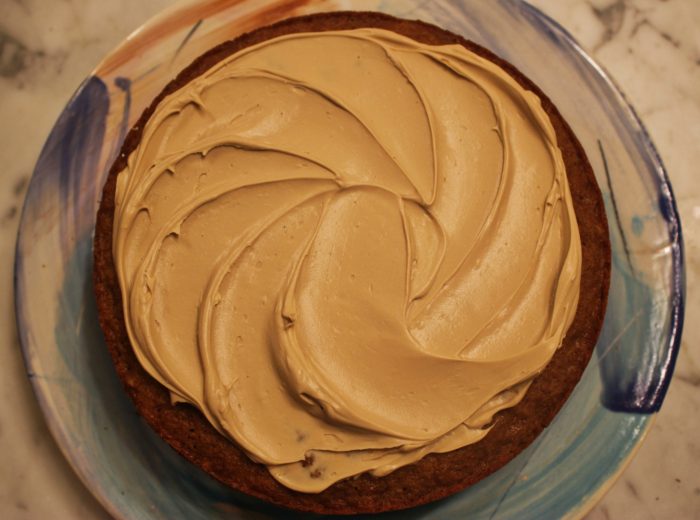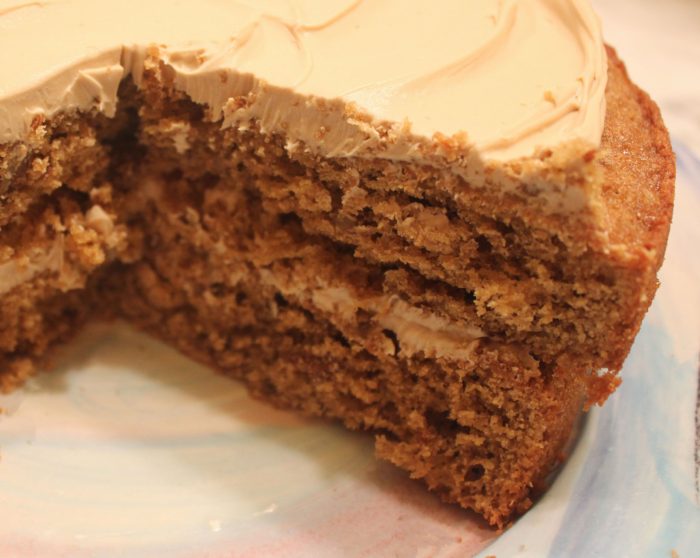

Sometimes it is fun to confuse people.
At her cooking school in New York City, Cooking by the Book, Suzi employs a staff of twenty with many professional chefs. We offered one of them, a superb dessert maven, a bite of this cake.
He tasted, he smiled, then he scowled. “What is it? Is this chocolate?”
No, no chocolate here. Lots of espresso powder but no chocolate. So this can’t even be called a mocha cake. It’s just expresso.
In her lovely Kitchen Magic book, Gizzi Erskine supplies a classic recipe: Victoria Sponge. It’s just what the Queen dined on. Two layers of soft sponge cake, separated by whipped cream and strawberry jam. The whole assembly dusted with powdered sugar. All you need is tea on the side.
And this classic sponge recipe is given to you below. Followed then by Gizzi’s “slight” amendment. Espresso power and nut pieces in this variation. Gizzi wants walnuts. Suzi prefers pecans, which I agree give a richer, more sophisticated flavor. Nothing personal, but walnuts can be a bit harsh. No whipped cream either. Instead, an icing made of mascarpone, heavy cream, and more espresso powder. The icing has no sugar, so it is completely healthy.
This will become a “go to” dessert for you, in either the original classic or this modified version. Oh, Gizzi has a lemon option, too. For that, I suggest you buy your very own copy of Gizzi’s Kitchen Magic!
Espresso and Nut Victoria Sponge Cake from Gizzi Erskine
Yield: serves 4+, depending on your appetite and other goodies on the table
Ingredients:
For the original classic sponge cake:
- 170g softened butter, plus extra for greasing
- 170g golden caster sugar
- 3 large free-range eggs
- 170g self-rising flour
- 1 teaspoon baking powder
- 2 tablespoons milk
- 1 teaspoon vanilla extract
- 3 tablespoons chunky strawberry jam
- 150ml double cream, whipped softly
- Icing sugar, for dusting
For espresso and nut option:
- 1 ½ tablespoons espresso powder
- 2 tablespoons of boiling water
- 85 grams of nut pieces [walnut or pecan]
- 250g mascarpone
- 100ml heavy cream
- 1 tablespoon espresso coffee powder
- 1 teaspoon boiling water.
Preparation for the classic sponge with whipped cream and jam:
Preheat the oven to 340°F. Butter and line two 20cm [8 inch] sandwich cake tins. Place the butter and sugar in a mixing bowl and beat together with an electric whisk for around 5 minutes, or until they become pale and creamy. Whisk in the eggs, one by one, until they are combined (you may find the mixture splits a little when you pop in your last egg).
Sift over the flour and the baking powder and fold them in using a metal spoon. Loosen the mixture with 1 tablespoon of milk and the vanilla extract. You want the batter to fall off the spoon easily, so if you think it’s still too thick, stir in the other tablespoon of milk.
Divide the mixture between the sandwich tins and bake for 25 minutes, or until golden and cooked through. You can check this by sliding a skewer into the cake; if it comes out clean it’s done.
Leave the cakes to cool in the tins for 15 minutes, then transfer them carefully to a wire rack to cool completely.
If the cakes have rounded tops, carefully cut the rounded part off one of them (this will be the base). Spread this half with the jam, then top with the whipped cream. Sandwich with the other cake, then place a little icing sugar in a small sieve and dust the top. Needless to say, you have to serve this cake with a cup of tea!
Preparation for the espresso and nut version:
Add the 1 ½ tablespoons of espresso powder to 2 tablespoons of boiling water. Use this mixture instead of the milk. Stir in the nut pieces with the flower.
Fill and ice the cake with the mascarpone and heavy cream, plus the tablespoon of espresso powder diluted in 1 teaspoons of boiling water.
Source: Gizzi’s Kitchen Magic by Gizzi Erskine [Virgin Digital, 2012]
Photo Information [Top]: Canon T2i, EFS 60mm Macro Lens, F/4 for 1/30th second at ISO‑160
Photo Information [Bottom]: Canon T2i, EFS 60mm Macro Lens, F/4 for 1/50th second at ISO‑800
